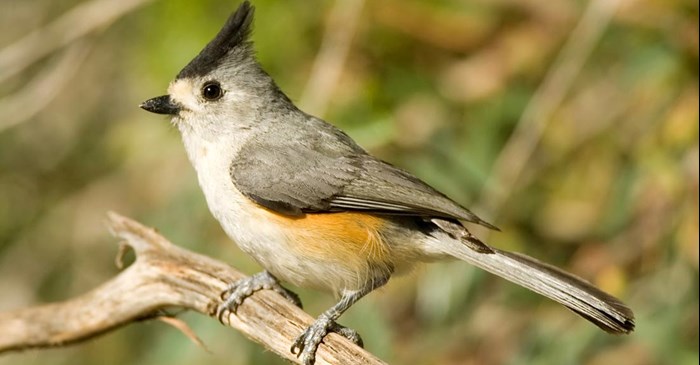No place but Texas is home sweet home for the Black-crested Titmouse.
Well, almost. These handsome cousins of the Tufted Titmouse can be found flitting in the scrublands of south and central Texas, with territories occasionally crossing into the Rio Grande Valley, entering northern Mexico, with flocks spotted in southwestern Oklahoma.
What’s the story behind these tiny birds of the Longhorn State?
How to identify the Black-crested Titmouse
The Black-crested Titmouse is a light gray bird with a bold, black crest. Their wings are dark gray and they sport shades of peach on their sides. Despite these distinctions, the Black-crested Titmouse looks, behaves and sounds very similar to the Tufted Titmouse. In fact, when they encounter each other in overlapping territories, they’ve been known to interbreed. A hybrid titmouse sports a gray crest with a distinct reddish-brown spot on the forehead.
These factors probably led scientists to believe that the Black-crested Titmouse was a subspecies to the Tufted Titmouse. In 2002, the Black-crested Titmouse was recognized as its own species. Genetically, the two bird species are different, plus there are differences in how the two birds sound. Scientists estimate the divergence took place some 250,000 years ago.
Where to find the Black-crested Titmouse
By summer, the Black-crested Titmouse is a true friend of the gardener, eating caterpillars, spiders, snails, wasps, bees, beetles, as well as insect eggs and pupae. In the winter months, a diet of acorns, seeds, and shriveled fruits and berries helps them thrive. Unlike finches, their small, slender beaks are not well-suited for smashing seed hulls. Like their titmouse and chickadee relatives, they’ll hold down the nut or seed with their feet, using their beaks to chisel off bites of meat.
Backyard tips for the Black-crested Titmouse
You’ll find these tiny birds flitting about the oak-juniper scrublands of the river valley, sometimes clinging upside-down on branches to access food. They’re also well-adapted to urban areas, finding their way to parks and yards.
If you live in a more developed area, setting up a nesting box is a great way to support the Black-crested Titmouse. In the wild, they nest in holes excavated in the softwood of dead or dying trees. Set up a nesting box well before the start of the springtime nesting season. In fact, you can even do it before winter, and it may provide some much-needed shelter on chilly nights!
The Black-crested Titmouse will also visit bird feeders. Attract these cuties with the blend of sunflower seeds, nuts, and dried fruit found in Lyric Fruit & Nut Mix.
